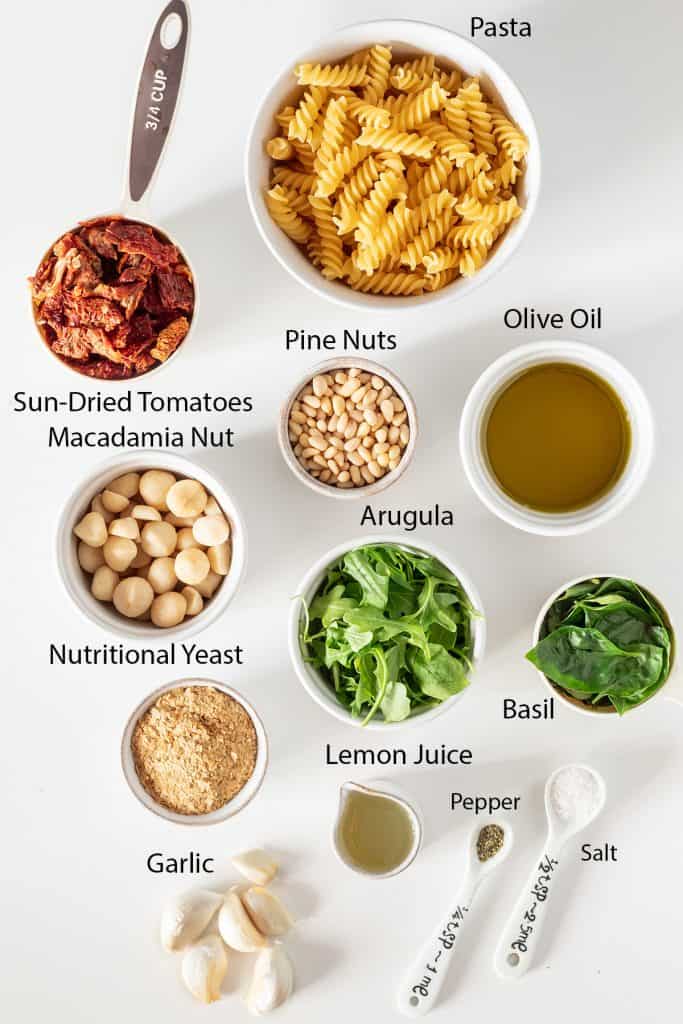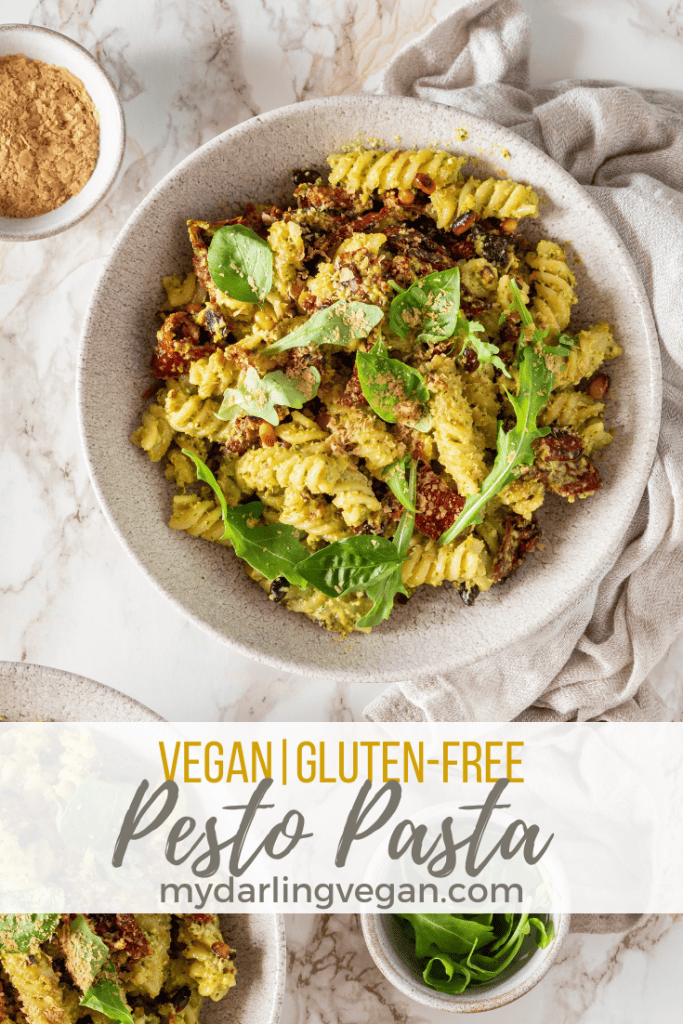This Vegan Pesto Pasta is a symphony of flavors - fresh basil, peppery arugula, tangy sun-dried tomatoes, and sweet, buttery pine nuts. As a bonus, you can make this impressive meal in just 30 minutes from start to finish!

Disclosure: This post may contain affiliate links.
While this vegan pesto pasta might pack a heck of a punch in the flavor department, you can rest assured that it takes just 30 minutes to get on the table. It's the perfect weeknight meal for warm weather and is lovely enough to serve to company.
My simple vegan pesto recipe is perfect for using up all of your summer bounty, but this delightful dish uses sun dried tomatoes to provide brightness without having to wait for fresh July tomatoes. In fact, if you do like I do and make extra pesto to freeze after summer ends, you can enjoy this yummy pasta any time of year!
Now that warmer weather is upon us and there's hope around the corner, I'm all for celebrating with friends. This easy pesto pasta recipe is perfect for a no-fuss dinner with loved ones. If the pesto is already made and in your fridge, the rest of the meal will come together in the time it takes for your pasta to cook. That leaves you with plenty of time to sit around the table with your nearest and dearest.
Recommended Ingredients & Equpiment
Let's get cooking, shall we?? This easy weeknight vegan pasta dish comes together with just 15 minutes of active time in the kitchen.
Here's everything you'll need to get started:

Ingredient Notes
- Fusilli - While I love the awesome sauce grabbing power of the spiral ridges on fusilli, this vegan pesto pasta dish will do well with any short pasta with some good texture and divots like rotini, cavatappi, gemelli or orecchiete.
- Sun Dried Tomatoes - Feel free to use either dried or olive oil-packed sun dried tomatoes for this recipe. If you opt to use dried, I suggest plumping them up with a few tablespoons of boiling water prior to using. If you use oil packed, be sure to use that tasty olive oil instead of just chucking it!
- Arugula - I use a double dose of this peppery green by adding it to both the pesto and tossing whole leaves of it into the finished pasta dish. If you're unable to find arugula, I recommend replacing the pesto portion of it with fresh basil. For the assembled pasta dish, fresh baby spinach makes a nice replacement.
- Basil - Opt for fresh, bright and undamaged herbs here. Feel free to toy with the flavor (and color!) of your pesto by using heirloom basil varieties.
- Pine Nuts - Pine nuts are some of the most expensive "nuts" on the market - they're actually a seed - which is why I opted to only use them for the finished pasta dish. Their buttery, subtle flavor and tender texture is unrivaled, so I highly suggest splurging if you can. If they are not available to you, try swapping in chopped, toasted macadamias or cashews.
- Macadamia Nuts - While macadamias share some of the creamy consistency and subtle flavor of pine nuts, they're generally more affordable per ounce. In a preparation like pesto where the nuts are pulverized, they're a near perfect replacement for pignolias. If you are allergic to nuts, you can opt to use pine nuts (which are actually seeds) instead.
- Nutritional Yeast - Nutritional yeast is a common food additive made from deactivated yeast and is common in vegan cooking. It adds a nutty cheesy flavor that is perfect for replicating a cheesy flavor without any animal products.
- Lemon Juice - Fresh is best when it comes to tart citrus juice. To get the most juice out of your lemons, roll them firmly on the countertop for about 15 seconds before cutting.
- Garlic - Since we're making pesto here, definitely opt for fresh garlic. Feel free to save some time by purchasing pre-peeled cloves.
Recommended Equipment
For this quick weeknight pasta recipe, you'll need a high powered blender or food-processor, a stockpot, colander, and sauté pan, as well as basic kitchen utensils. (<<affiliate links)
Step-by-Step Instructions
My Vegan Pesto Pasta with Arugula is a true weeknight wonder. It's as easy as 1-2-3! Follow along with my step-by-step instructions and you'll have a bright, fresh tasting dinner on the table in no time.
Step One - Boil Pasta
Fill a large pot with at least 6 cups of water and place over medium-high heat. Cover and bring to a boil. Once boiling, stir in pasta. Return to a boil, then reduce heat to a low simmer. Cook for 7-9 minutes, stirring occasionally until pasta is cooked all the way through. Strain through a colander and set aside. NOTE: Refer to the package directions for your pasta, as cooking times may vary.
Pro Tip: What to learn how to make the perfect pasta every time? Check out this helpful article.
Step Two - Make Pesto

While pasta is cooking, make the arugula pesto. Combine the basil, arugula, macadamia nuts, nutritional yeast, lemon juice, and garlic cloves in a food processor and pulse for a minute, scraping down the sides as needed. With the motor running, slowly add in the olive oil. Blend well. Salt to taste.
Step Three - Assemble

In a large skillet, heat 1 tablespoon of olive oil over medium heat. Add tomatoes, garlic, and pine nuts, stirring frequently until garlic is fragrant and pine nuts have begun to brown.

Remove from heat and stir in pasta and pesto, until the pasta is evenly coated. Stir in fresh arugula and serve immediately. Enjoy!

Serving and Storing
Serving - For best results, serve the pasta immediately after tossing with pesto and arugula.
Storing - Any assembled pasta leftovers will keep in the fridge for up to 3 days. If you have any leftover pesto, cover with a thin layer of olive oil and refrigerate for up to 3 weeks.
Reheating – To reheat your pasta leftovers, you can either cook them in the microwave in 45-second increments or reheat on the stovetop. Note that if you opt for the stovetop method, you may need to add a tablespoon or so of water to loosen the sauce so that it doesn’t stick to the pot.
Tips and Tricks
- Salt your pasta water! You only get one chance to make sure your pasta is seasoned, so make sure to take the opportunity. Pasta cooking water should taste about as salty as seawater for best results.
- Cook the pasta to al dente to avoid mushy pasta. If you use thicker or thinner noodles, I recommend following the box’s instructions to cook the pasta al dente. Cook times can range from 5 to 6 minutes to 12 or more depending on the variety.
- If you plan on having leftovers, save a handful of arugula. When you reheat the leftovers, I find that you can replicate the look and taste of the first bite if you have freshly wilted arugula woven throughout.
- Have leftover pesto? Cover it with a thin layer of olive oil before popping it in the fridge. The oil will prevent air from touching the pesto, which will help to keep the basil from oxidizing and turning brown. Refrigerated pesto covered with oil in this manner should last between 1-3 weeks in the refrigerator.
- You can also easily freeze leftover pesto to keep for up to 4 months! I highly suggest freezing it into ice cubes to make it easy to grab only what you need.
Frequently Asked Questions
For the vegan pesto, I actually opted to use macadamia nuts instead of pine nuts. While I love the subtle textural pop that pine nuts give to the final product, I realize that they can be a bit costly and difficult to find. If necessary, feel free to sub chopped macadamia nuts or cashews in place of the pignolias.
I love the spiral ridges of fusilli because it does a great job of holding onto the pesto. That said, you can substitute other short pastas that have ridges or pockets like rotini, gemelli, or even orecchiette.
While I love the peppery punch that arugula lends to this vegan pesto pasta dish, it will still be tasty without it. I recommend replacing it with an equal amount of fresh basil for the pesto, and opt for any dark, leafy green of your choice for the pasta. Just note that spinach will wilt as easily as arugula, while heartier greens like kale or chard should be sautéed with the sun dried tomatoes to help achieve the appropriate consistency.
Most pesto recipes call for parmesan cheese. In this vegan version, we swap in nutritional yeast, which provides all the umami, "cheesy" flavor without any animal products.
More Vegan Pasta Recipes
If you need even MORE inspiration, check out my 11 Easy Vegan Pasta Recipes post! And get all my vegan pasta recipes for easy weeknight meals.

Vegan Pesto Pasta
Ingredients
Arugula Pesto
- ½ cup fresh basil, packed
- ½ cup fresh arugula, packed
- ½ cup macadamia nuts
- 3 tablespoons nutritional yeast
- juice of 1 lemon
- 3 garlic cloves
- salt, to taste
- ¼ cup olive oil
Pasta
- 2 cups uncooked Fusilli pasta
- 1 tablespoons olive oil
- 2-3 cloves garlic, minced
- ¾ cup sundries tomatoes, chopped
- ¼ cup pine nuts
- 1 large handful arugula
- salt and pepper, to taste
Instructions
- Fill a large pot with at least 6 cups of salted water and place over medium-high heat. Cover and bring to a boil. Once boiling, stir in pasta. Return to a boil, then reduce heat to a low simmer. Cook for 7-9 minutes, stirring occasionally until pasta is cooked all the way through. Strain through a colander and set aside.
- While pasta is cooking, make the arugula pesto. Combine basil, arugula, macadamia nuts, nutritional yeast, lemon juice, and garlic cloves in a food processor and pulse for a minute, scraping down the sides as needed. With the motor running, slowly add in the olive oil. Blend well. Salt to taste.
- In a large skillet, heat 1 tablespoon of olive oil over medium heat. Add tomatoes, garlic, and pine nuts, stirring frequently until garlic is fragrant and pine nuts have begun to brown. Remove from heat and stir in pasta and pesto, until the pasta is evenly coated. Stir in fresh arugula and serve immediately.
Notes
- Salt your pasta water! You only get one chance to make sure your pasta is seasoned, so make sure to take the opportunity. Pasta cooking water should taste about as salty as sea water for best results.
- If you plan on having leftovers, save a handful of arugula. When you reheat the leftovers, I find that you can replicate the look and taste of the first bite if you have freshly wilted arugula woven throughout.
- Have leftover pesto? Cover it with a thin layer of olive oil before popping it in the fridge. The oil will prevent air from touching the pesto, which will help to keep the basil from oxidizing and turning brown. Refrigerated pesto covered with oil in this manner should last between 1-3 weeks in the refrigerator.
- You can also easily freeze leftover pesto to keep for up to 4 months! I highly suggest freezing it into ice cubes to make it easy to grab only what you need.



 Hi, I’m Sarah. I’m a 14-year (and counting) vegan, professionally trained photographer, former pastry chef, founder of My Darling Vegan, and author of the
Hi, I’m Sarah. I’m a 14-year (and counting) vegan, professionally trained photographer, former pastry chef, founder of My Darling Vegan, and author of the